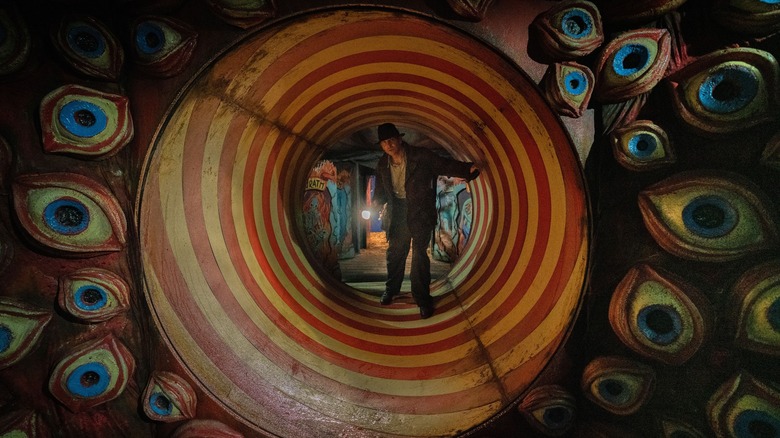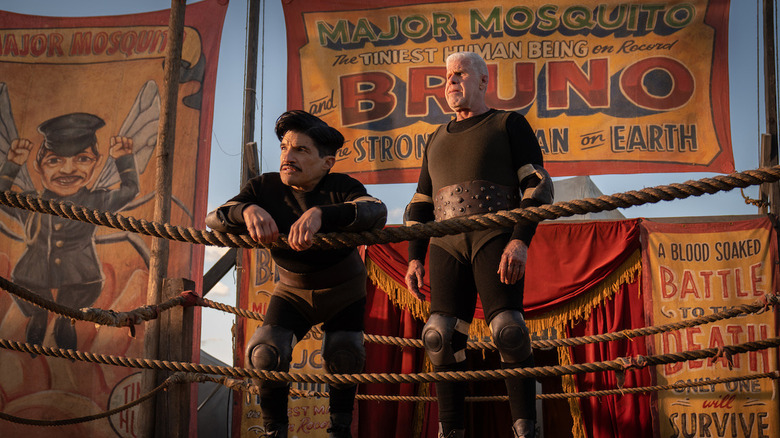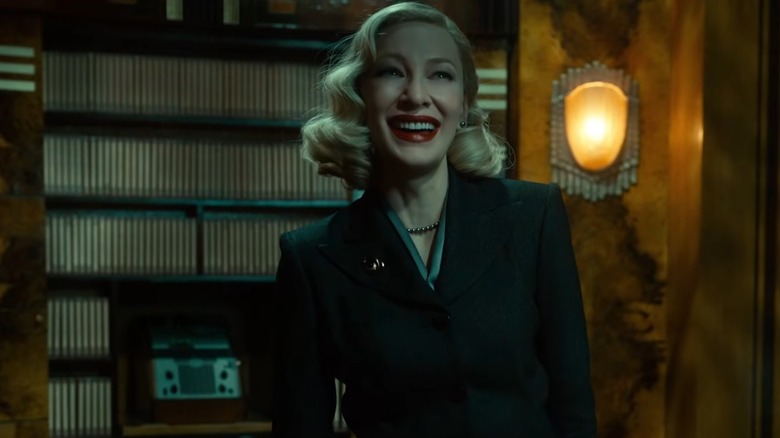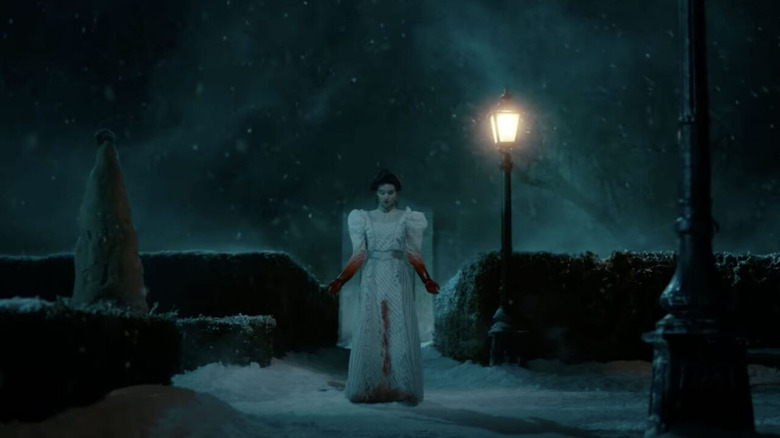Nightmare Alley Production Designer Tamara Deverell On Making A Functioning Carnival [Interview]
Tamara Deverell and Guillermo del Toro have been working together for years. The two first collaborated on 1997's "Mimic," which their latest film, "Nightmare Alley," references with a fun and unexpected Easter egg. (Read on to find out what it is.) Deverell was the art director on that monster film, and around that time, she was also the art director for David Cronenberg's "Crash" and "eXistenZ." Years later, she would reteam with del Toro to work as the production designer on his vampire TV series "The Strain."
With "Nightmare Alley," the two create quite a visual feast together. As del Toro is fond of saying, it's not eye candy, it's eye protein. From the carnival to the elaborate sets and the long and tall hallways which make protagonist Stanton Carlisle (Bradley Cooper) look like a small man in over his head, the production design was all about character. Recently, Deverell took us behind the scenes of "Nightmare Alley," explaining the film's most elaborate and eye-catching sets.
"It was all about 'Repent. Sinners, repent.'"
You and del Toro wanted to make the carnival as practical as possible, right? It mostly functioned, correct?
Yeah, yeah. So for the carnival, we did tons of research on '30s carnivals and carnival banners, because we made all those banners. We built every stick of it. There wasn't anything that we just rented. Everything was built. It was really a custom job.
It's interesting, we had a family company in the states in the Midwest. I think it's called Armbruster. They've been building tents for carnivals since the 1890s or 1840s or something, like Barnum & Bailey. It's this family tradition. And so, we had them custom build all our carnival tents. They were all custom dyed and aged. We had amazing fabric treatment, ager painters, and then we sent it down to them and they assembled them, sewed them together and sent them back to us with the poles and the period poles. They totally got it. But they were very customized. You don't just find tents like that anywhere.
Even though it's noir and fairly stylized, how faithful to the period were you?
Pretty faithful. We didn't talk about noir when we did it. Guillermo's first reaction was, 'Let's not say we're doing a noir film and let's not look at noir films that much.' We all watched the original "Nightmare Alley," but he didn't want to get bogged down too much in that idea of us copying something else, because really it's Guillermo's vision that we're all supporting.
We looked at a lot of paintings. We looked at Andrew Wyeth and Edward Hopper and this painter, Hammershøi, this Danish painter for composition and color palettes and Matisse and Picasso and their periods of brilliant colors. And for the carnival, we layered it in terms of art history more than just movie history, because Guillermo has a very specific vision.
Tons of research, though. The banner research we did, we actually bought a couple of banners. We bought a couple off Fred Johnson, who's the Picasso of the carnival banner manufacturing aspect of all carnivals. Anybody who knows about carnival banners knows about Fred Johnson. We actually had a couple of those and we learned to imitate them, but imbue them with our characters.
The funhouse was very particular in terms of, we actually used devil dioramas that were from the 1800s in France and we had these crazy books, so they weren't just carnivals, but we did a lot of layering of what we learned about carnival banners and carnival books onto some of our own sort of Guillermo-esque references historically, especially in terms of art history.
That funhouse is creepy fun, but along with all the signs, that use of smoke and mirrors feels right.
It was all about "Repent. Sinners, repent." The whole idea of the funhouse was this place where you go and you look at yourself as a sinner and we had the seven sins. I mean, there was a lot you actually don't end up seeing in the film, but we had the seven sins painted and panels as you come in. So you'd see a few of those. You'd see lust.
So Guillermo would put the ones that meant something to him. And then he goes through and we did that funhouse mirror where the character Stan looks into himself and says something about, "Are you a sinner? Repent now, sinner." And then it was all devils and everything moved. And actually, it was too much and Guillermo didn't have so many moving parts in the final thing, but building that twirling drum, that's a kind of carnival classic staple, then into the eye, this room with the eyes spinning, that was 100% del Toro's [way of saying], "Let's get weird with this." It was very strange. We sculpted all these eyes and plastered them on a wall. It was fun.
How'd you get the pickled punks [Editor's note: the fetuses in jars at the carnival] just right?
Well, those existed in carnivals, so they were real. We got different shaped jars that we liked and we spent a lot of time putting those jars together. And our prosthetics guys made the little, the pickled punks, the little fetuses and the pigs that are in there. They were all created by us.
For me, that was more trying to put them on shelves and create this kind of –- everything in "Nightmare Alley" was about doing alleys of spaces, walking through alley spaces. So, we had those shelves of the pickled punks that you walk through to Enoch [the creature with a third eye]. It was all thematically in the design of the film, this moving through spaces to an end-entity, even Lilith's office became this alley of sorts because it was very long and narrow. It was a constant theme.
But creating the pickled punks, we had to create the amber liquid. We did tests of different viscosities and tones of amber liquid to get them just right. And then to light them, we made these little half shell carnival lights that specifically lit them from behind. So they could be backlit and they could float and do all their weird things. I have one of them in my basement. One of them.
Which one?
Just one of the background ones. We were like, 'We can't really keep them.' When we were getting rid of them in the end, I was like, 'Oh, I'll take it.' Every once in a while I go down to my basement, like, 'Oh God, what am I going to do with that pickled punk?'
Have you considered leaving it out on a coffee table when you have guests?
I should, yeah. I try to give it to my kids, but even they don't want it. I'm storing it for my daughter.
"You can't fake stuff like that."
When Stanton goes to Lillith's office for both the first and the last time, you really get that sense of being in a long alley, like you said.
Yeah, totally. It was actually a combination of, we built part of that alleyway hallway on set, but the longest part of the hallway was on location in Buffalo, which is this upstairs hallway in the city hall where we shot. It was incredible.
It was so simple. We painted the whole thing and we did all the lights in it, but it was just such a stark, simple motif to go from Lilith's office with all this wood and intricacies and the Rorschach wood veneer thing that we did, and then come out to this stark alley. And that moment when he runs out and smears blood on the wall, that's a transitional moment. I really loved how that works.
The Rorschach wood veneer, did you discover that in your research?
Yeah. Actually, in the Brooklyn Museum here in New York, there's a floor that has all these different styles. There were all these wood veneers, which, when you think of art deco, you often don't think of wood so much, but there was a lot of wood in it and it just hasn't lasted as well. It's not a set, it's an actual room that they transplanted into the museum. I said, "Someday, I have to do this. I have to do this on a set."
When we started to talk about Lilith's office, I showed Guillermo some pictures of this room. He loved the idea of the wood and the warmth. So basically, I spoke to the curators there and we copied the way that study was built with all of the wood veneers that form these crazy Rorschach shapes. Of course, we played with that a lot more and wanted to get crazier, but it was all natural olive wood. It's just lacquered and veneered, every bit of that. We didn't paint it. You can't fake stuff like that.
So we started this little study in Brooklyn and then Guillermo kept stretching it and stretching it with me, making it longer and longer. And it became like a train, like a train car, really, in its length. That was also with Dan Laustsen, the DP, who could get these crazy long angles and have them walk, have Lilith move through this space. I did think a lot about Cate Blanchett and how she moves and how she'll be that character, because she's, to me, very inspirational as an actress.
I could see how with her red lips and what Luis [Sequeira] was doing for her costumes and just the whole look coming together in her office, the way was surreal. That was one of my favorite sets. I completely forgot about it too, until I saw it last night, I was just not even thinking about it, but when I saw it, I was just like, "Oh, wow."
I heard someone make a good point that she's imposing on-screen, but with such stillness.
Yeah, yeah. So poised. Just her body language in that and the way she crossed her legs. Anyways, I could go on and on about Cate Blanchett. One of the best moments of the film for me was when she arrived and we were all done and she was getting her makeup done. I ran into her outside the set somewhere and she grabbed me and she said, "You are amazing!" This was before the pandemic and we didn't have masks on. I was like, "Oh my God, Cate Blanchett just is grabbing me saying I'm amazing." Last night during the premiere, she mentioned how the sets were so fantastic. And it's just so nice to have an actress that just appreciates your work and it helps them with their character.
I do work from character a lot. I try to. And so, it was hard with "Nightmare Alley" because Stan didn't have a place in that movie. Part of it is he's not centered in one. Like Grindle had an office and a factory and a house, and Lilith had her office, but Stan was such a grifter and a drifter. I couldn't place him as a character as the main character in any one setting. I was more focused on him moving through these spaces being homeless almost, which is part of, for me, the theme of Stan: He never finds his place.
He's also such an empty vessel to some degree.
Yeah. And we use some visual sort of thematic licenses like circles throughout. You see them in the Copa in the dressing room, you see them in the carnival, you see them at the very end. We had big round windows and there were thematic little tricks or little Easter eggs that we put through that I was trying to use to frame Stan, which was interesting in and of itself to frame him.
"Stan is beyond saving at that point."
For the Copacabana, how close did you want to get to what it was really like?
The actual location we shot in, interestingly, is called the Carlu and it's a beautiful original art deco building that's been restored in the last couple of decades, beautifully. Not that we didn't do a ton of work there, but to its original self. I think there was more than one Copacabana club in New York. Buffalo in the '30s and '40s was a big contender. It was almost New York, really. I think people found it just snowed there too much or something. The Copa is fictionalized, but again there, the Carlu in and of itself as a location is a round room.
And so it has this round ceiling and then we built this giant round platform because Guillermo was like, "I can't see the ceiling because the floor is too low." We raised Stan and Molly up by doing this big tiered wedding cake of a platform. There was another circle motif. It's a beautiful location. I've shot it before. I've actually built it on "The Strain," another Guillermo thing. We built a smaller version of it that then got used in "Shape of Water" for a restaurant. So I knew it intimately. Guillermo said, "I can't. You have to build this, I can't shoot here because the ceiling's too high." I was like, "Okay, we're going to bring you up to the ceiling." And that's what we did. It worked beautifully.
What about the garden?
That is another location we built the back part of it, where the back area we actually built and we built it in a parking lot near the stage, and it sort of existed. There are a lot of visual effects in that particular set, but the garden itself exists. It's in Oshawa, which is near Toronto. It's called Parkwood Estate and it's an old mogul's mansion. When you see the house in the background, that house actually isn't there. VFX scanned the house and put it there. It's there, but it's around the corner. You can't see it.
It's actually just an ice cream stand where they meet and he's got flowers, he's got this monument to the woman who died, this art deco sculpture that we made. And then a lot of work snow dressing — even though it did snow while we were shooting there, we had to still keep the snow consistent. We did a lot of snow dressing and a few manufactured greens to make it what we wanted, like the alley where that scene ends. It was a real combination of location and set build.
You get a pretty good idea of how del Toro feels about organized religion, especially in this movie. You can't help but laugh when you see the "Jesus Saves" sign. How'd the themes about religion, false hope, and leaders inspire you?
It's interesting because I'm not a religious person. I come from it from a very different idea of religion. I think I tend to romanticize religion. Guillermo was brought up in a very staunch Mexican Catholic family, so he has lots of ideas about it and he's constantly struggling with ideas of morality and good and bad. Like, his themes are very universal and basic in many ways, that he explores the intricacies of it. There's always that kind of like, 'You are a sinner, we're all sinners,' this idea that nobody's perfect. I think Guillermo spoke to that a little bit last night and we're all flawed and we don't realize who we really are and what our moral good is and what our moral depth is. He is constantly exploring that.
The "Jesus Saves" neon that we built was actually a little bit of an Easter egg. Years ago, I worked with Guillermo on a movie called "Mimic." We built that same cross, that same Jesus Saves, very similar. It played where this priest is running away from the creature monster and falls with this big neon sign in the background. When Guillermo said, 'Let's do that sign again,' I was like, 'Oh my God, I can't believe I'm designing and building that sign again.' It was fun to do it again. On the night they were shooting it actually fritzed. They had rain towers and a lot of rain and it fritzed and I was getting calls from the set, having already opened the set and gone home for the night, 'The sign's not working!' I'm like, "Well I'm not an electrician. I don't know!" So apparently it went on the fritz and they shot the scene without it. They said, 'Okay, the VFX will shoot it and they'll fix it after.' And then as soon as they finished shooting the scene, one of the electricians took the plug and fiddled with it and it went on. The whole thing was working the whole time. So I was like, 'Oh my God, I can't believe this happened.' We all felt really bad. Then I noticed in the film last night, he left it off. He let it fritz and go off and I thought, 'Oh my God, that is so brilliant because, really, it shows sort of the demise of religion and the demise of morality, bringing this dead guy down and Jesus saves, but who's Jesus saving?" Really, you're asking that question and Stan is beyond saving at that point. It's one of those moments in the film where you go, 'Morally, this guy, he's going down a deep dark alley now.'
"Nightmare Alley" is now in theaters.



